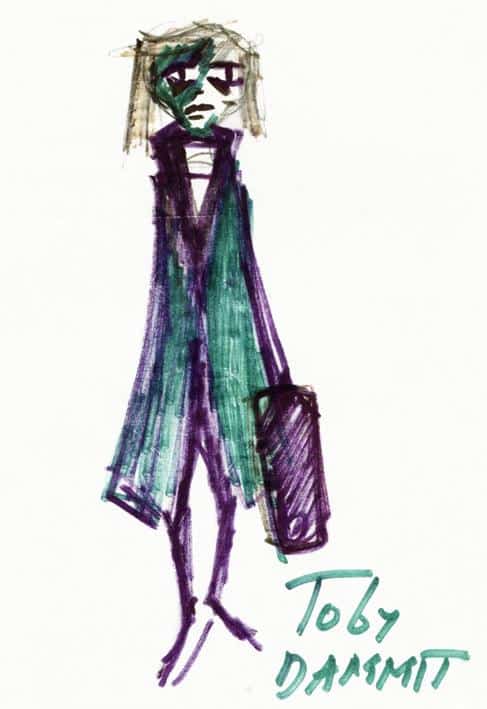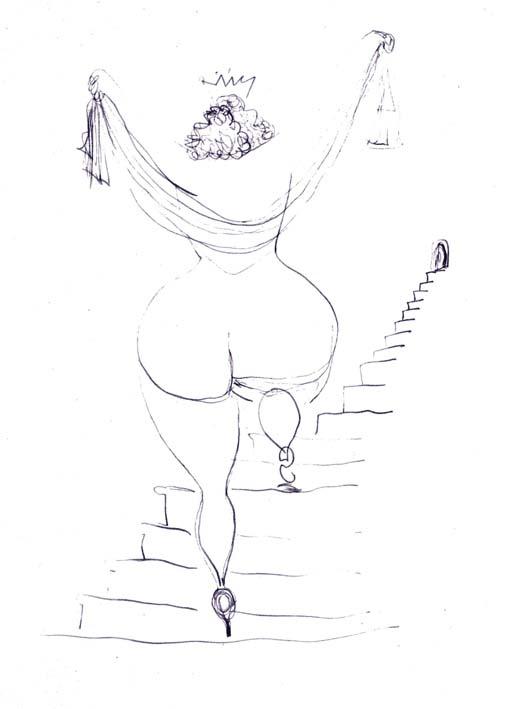Articles and Features
The Other Federico Fellini: The Drawings Of The Legendary Auteur

By Shira Wolfe
“Fellini was a cartoonist, I was a cartoonist. We both came from the same background. Which means you look at the world and you stretch it, you pull it, you distort it.” – Terry Gilliam
Often, great artists wear many different hats, but break through and achieve acclaim because of their work in one specific medium. We aim to highlight the multifaceted nature of their talent by shining a light not on what they are best known for, but on the lesser-known side of their artistic production. Federico Fellini (1920-1993) is one of the greats of Italian cinema, who became known for a remarkable and outspoken style blending fantasy and realism, and filled with eccentric and colourful characters. Films like La Dolce Vita, La Strada and 8 ½ remain some of the most influential films in the history of cinema. The director was also an evocative visual artist whose drawings were integral to his creative process.

Federico Fellini – A Caricaturist
Federico Fellini first started making a name for himself as a caricaturist when he was in high school. He was hired by the manager of the Fulgor cinema in his hometown of Rimini to draw portraits of Hollywood stars in order to promote movies. In exchange for these drawings, he received movie tickets – thus beginning a lifelong connection between his graphic and cinematic imagery. From 1938, he started collaborating with “Domenica del Corriere”, which published his cartoons, and with the comic publication “420”. When Fellini moved to Rome – under the pretence of studying law – he joined the editorial staff of “Marc’Aurelio”, which was a well-known satirical magazine. It was there that the young Fellini became popular, through hundreds of drawings that he signed as Federico. Fellini soon moved on to cinema, but drawing remained an important element of his artistic expression throughout his career.

“Why I draw the characters of my films? (…) Perhaps I have already told that it is a way to start watching the film in face, to see the type it is, the attempt to fix something, even though minuscule, to the limit of the nothingness, but that seems to have something to do with the film, and covertly it speaks to me.” – Federico Fellini

Drawing the Characters of his Movies
Before or during the shooting of his films, Fellini frequently drew the characters of his movies. When asked why, the director explained:
“Why I draw the characters of my films? Why do I take graphic notes of their faces, of the noses, of the moustaches, of the ties, of the bags, of the way to cross the legs, of those people that come to visit me in the office? Perhaps I have already told that it is a way to start watching the film in face, to see the type it is, the attempt to fix something, even though minuscule, to the limit of the nothingness, but that seems to have something to do with the film, and covertly it speaks to me.”

Fellini believed in developing a character by drawing that character, a key part of his creative process. The drawing was the first step, and after that, finding the actor to fit the drawing. In his words: “Finding the actor to fit the drawing is more difficult. I look until I find someone who makes me think, ‘You, you are my drawing!’”
An example of Fellini’s sketches is one he did of Casanova while shooting his Il Casanova di Federico Fellini (1976). Fellini used the sketch to explore his ideas about the physical appearance of his Casanova character. In another sketch titled Dream, Fellini illustrates the death of the clown, representing the death of the circus. This sketch was the starting point for his 1970 film The Clown.

Fellini’s Erotic Drawings
Drawn to the eroticism of the female figure since childhood, Fellini loved to draw stylised erotic images: “Sometimes when I am casting, or in pre-production, or writing, my hand seems to draw without me. In those moments, I am most likely to do enormous female breasts. My second most frequent doodle is excessively large women’s behinds. Tits and asses.”
He drew the majority of his erotic drawings in the last years of his life. Often, they revive favourite characters from his movies, like the robust “Amazonian” woman luring the male hero. Fellini honoured this sex symbol in many of his erotic drawings, with her defining features greatly exaggerated. Fellini himself also appears in some of these caricatures, often as a miniature figure.

Fellini’s Style
Although he remains one of the most highly regarded, influential directors of our time, many people accused Fellini of depicting people as walking caricatures, making them too grotesque, odd and bizarre. Yet fellow director Terry Gilliam defended Fellini, explaining: “Fellini was a cartoonist, I was a cartoonist. We both came from the same background. Which means you look at the world and you stretch it, you pull it, you distort it.” This goes for all of Fellini’s drawings, whether you like them or not. At times, they may be crude and extreme, but they are Fellini through and through, born from his life as a cartoonist, and growing up with him and through him as he developed as a film director. For Fellini, film was the child of painting, borne from pictures that move.
Relevant sources to learn more
Discover Fellini’s drawings on the Fondazione Federico Fellini
Read about the visual art of Armenian-Georgian director Sergei Parajanov
Read about the visual art of legendary director Alejandro Jodorowsky